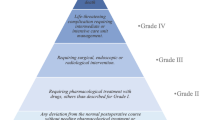Abstract
The ex-utero intrapartum treatment (EXIT) procedure is an uncommon operation indicated for fetal lesions with the potential to cause life-threatening airway obstruction immediately after delivery. By maintaining utero-placental circulation, the fetal airway can be evaluated and secured prior to delivery. The anesthetic goals for the EXIT procedure differ significantly from a cesarean delivery and include profound uterine relaxation, fetal anesthesia and maintenance of the maternal-fetal circulation. We present a case of an uneventful EXIT procedure and include a discussion of the anesthetic goals for this operation.

Similar content being viewed by others
References
Stevens GH, Schoot BC, Smets MJW et al. (2002) The ex utero intrapartum treatment procedure in fetal neck masses: a case report and review of the literature. Eur J Obstet Gynecol Reprod Biol 100:246–250
Kuczkowski KM (2006) Images in anesthesia: ex utero intrapartum treatment: fetal airway management. Can J Anaesth 53:1117
Manrique S, Blasco J, Munar F et al. (2007) Two cases of congenital airway obstruction managed with ex utero intrapartum treatment procedures: anesthetic implications. Rev Esp Anestesiol Reanim 54:45–48
Chan DF, Lee CH, Fung TY et al. (2006) Ex utero intrapartum treatment (EXIT) for congenital giant ranula. Acta Paediatr 95:1303–1305
Hullett BJ, Shine NP, Chambers NA (2006) Airway management of three cases of congenital cervical teratoma. Paediatr Anaesth 16:794–798
Dahlgren G, Tornberg DC, Pregner K, Irestedt L (2004) Four cases of the ex utero intrapartum treatment procedure: anesthetic implications. Int J Obstet Anesth 13:178–182
MacKenzie TC, Crombleholme TM, Flake AW (2002) The ex-utero intrapartum treatment. Curr Opin Pediat 14:453–458
Zadra N, Giusti F, Midrio P (2004) Ex utero intrapartum surgery: indications and anaesthetic management. Best Pract Res Clin Anaesthiol 18:259–271
Ducloy-Bouthors AS, Marciniak B, Vaast P et al. (2006) Maternal and foetal anaesthesia for ex utero intrapartum treatment (EXIT) procedure. Ann Fr Anesth Reanim 25:638–643
Balser JR, Butterworth J, Larach DR (2003) Cardiovascular drugs. In: Hensley FA, Martin DE, Gravlee GP (eds) A practical approach to cardiac anesthesia, 3rd edn. Lippincott Williams & Wilkins, Philadelphia, PA, pp 50–51
Acknowledgments
Presented in part by Dr. Krzysztof M. Kuczkowski, MD, at the 39th Annual Meeting of the Society for Obstetric Anesthesia and Perinatology in Banff, Alberta, Canada, May 16–19, 2007.
Author information
Authors and Affiliations
Corresponding author
Rights and permissions
About this article
Cite this article
Chang, L.C., Kuczkowski, K.M. The ex utero intrapartum treatment procedure: anesthetic considerations. Arch Gynecol Obstet 277, 83–85 (2008). https://doi.org/10.1007/s00404-007-0402-9
Received:
Accepted:
Published:
Issue Date:
DOI: https://doi.org/10.1007/s00404-007-0402-9




